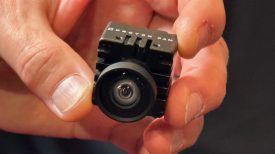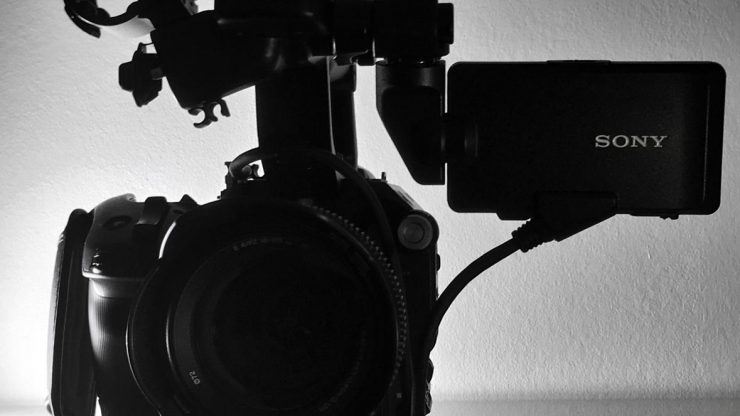
It wasn’t just bills and circulars on my doorstep last week: Sony’s new FS5 also arrived for testing. I’d seen the camera several times before, but this was a final production model and I was keen to try it out it in a real world environment. The company is marketing it not just as a grab-and-shoot camera but a ‘handheld hero’ – so would it live up to the hype?
I figured there was no better way to test it than to film my friend Kai for an episode of Digital Rev. We had a couple of hours on a grey and windy London afternoon to film the short video, which will be out in a few weeks. Almost everything had to be handheld because we were shooting at such a pace and the session allowed me to really get to grips with the camera itself.
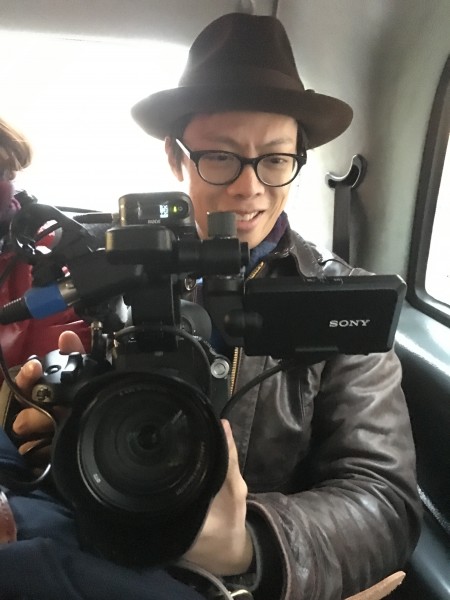
Lots more detailed thoughts on the camera in a moment, but if you want the short version it’s this: The FS5 is the ultimate fusion of DSLRs and old school video cameras like the Sony EX1.
Sony FS5: The Outside
First impressions are very good. The camera body weighs a mere 830g (1lb 13.2 oz), but it’s built solidly. Before trying it out this week it I hadn’t realised that it’s actually small enough to work with accessories aimed at DSLRs, rather than you having to build out a large rig as you would need to for its bigger brother the FS7. I’ve used it on my Sachtler FSB8 tripod head and Gitzo legs without any problems. It also works well on my little Steadicam Merlin and my iFootage and Kessler sliders can carry it without issues. It should also work well on a Kessler Pocketjib. I started testing it with a big quick release plate but soon realised that all I needed to mount it securely was a Zacuto Gorilla plate.
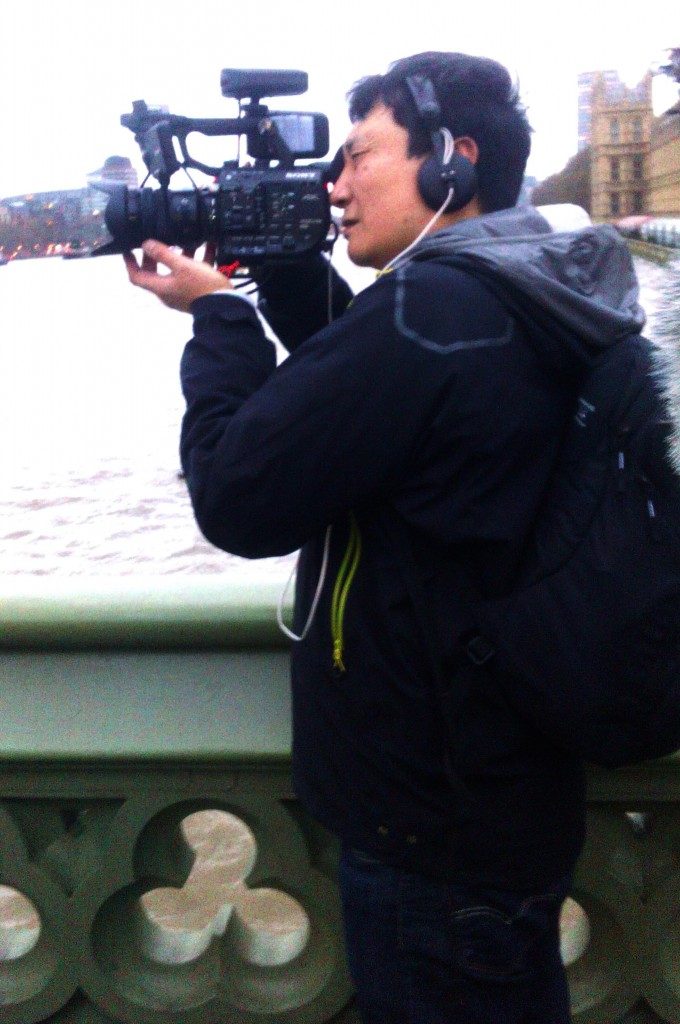
The compact body also makes it very suitable for use in brushless gimbals. I can see many high end users of Sony’s larger cameras picking up an FS5 just for gimbal work.
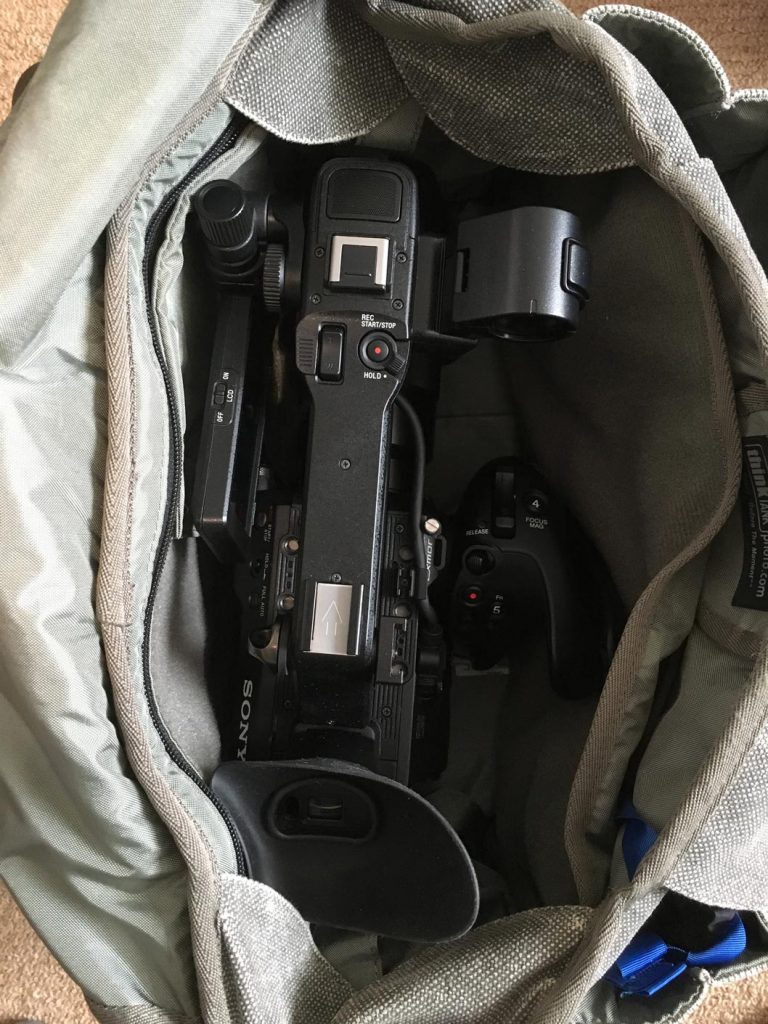
The top handle is comfortable, attaches via two screw points and has a trigger, a built-in stereo mic, a mic holder and one of the camera’s two XLR sockets. There’s also a zoom rocker control that can be used with the fly-by-wire kit lens or the Clear Image zoom. The handle comes off quickly and the electronics are connected via a special interface in the top of the camera so there are no dangling cables – something Canon could learn from on the C300 and C100.
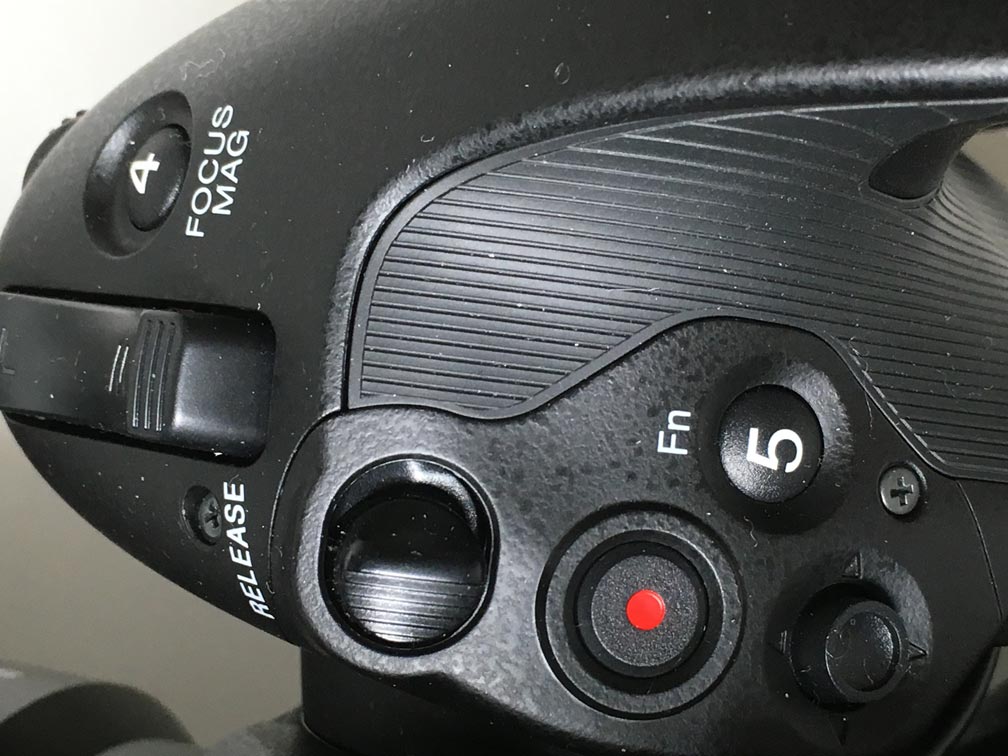
The adjustable handgrip feels good in the hand and should be comfortable even after long periods of shooting. It’s similar to the one on the FS7, except that it mounts via a special bayonet. It can be oriented up or down depending on your preference.
The dial on the grip does several new things: as well as changing iris, it can control the vari-ND and also manual focus. However, I tested the manual focus with the kit Sony 18-105mm lens and found it pretty hard to use accurately. Nailing the exact point of focus is difficult and you end up spinning the dial frantically if you want to rack quickly from one end of the focus range to the other.
The 18-105mm is a constant f4 aperture, which is a big plus compared to many other zooms of its type. It is also a power zoom lens which means that it can be zoomed via the rocker on the handgrip, camera handle, or on the side of the lens itself. The zoom speed is variable and can be set in the camera menu. There is an optical image stabilisation system that works very well. Optically it is a pretty good all-rounder; I wouldn’t say it has the nicest bokeh or definition, but it isn’t terrible. It distorts a little at the wide end, but thanks to the camera’s electronic in-camera distortion correction, the lens doesn’t produce the severe pincushion distortion that it exhibits on some other Sony cameras.
I found it great in terms of the size and balance, but it’s a focus-by-wire system which I found rather difficult to control. There are no focus marks and focussing manually I found it all too easy to overshoot the point of focus. I wish that the kit lens had mechanical focusing instead of electronic. If the autofocus system on the FS5 were better then maybe this would be less of a problem. A better lens option for run-and-gun shooting might be a Canon or Sigma 24-105mm f4 lens with a Metabones Speedbooster.
Autofocus is there on the FS5, but don’t expect the confident, fast performance of a Canon C-series camera with Dual Pixel CMOS AF. The FS5 autofocus is sluggish in comparison and feels very much like the system on the FS7. It may be OK for some subjects, but I still prefer to use the Sonys in manual focus.
The Variable ND is a different story: it’s one of the most innovative features of the camera and I was pleased to find that it works well. It’s either completely off, or when engaged you get between 1/4 to 1/128 ND by rotating a dial on the side of the camera. It can also be programmed to work like a conventional ND filter wheel, just stopping at three fixed strengths of your choice.
The built-in OLED EVF is just OK. It it’s a lower resoltion 1.44 million dots type and not as good as the one in the a7S, let alone the stunning one in the a7S II. This is a bit of a shame and I would have preferred to see a better one in there. Also, it exhibits a slight colour shift as your eye moves off-axis, which can be annoying. It is usable, though, and fairly close in resolution to the competing C100 mkII.
The 1.56 million dot flip out screen is nice and clear and looks very similar in quality to the one on the FS7, but lacks the loupe attachment to turn it into an EVF.
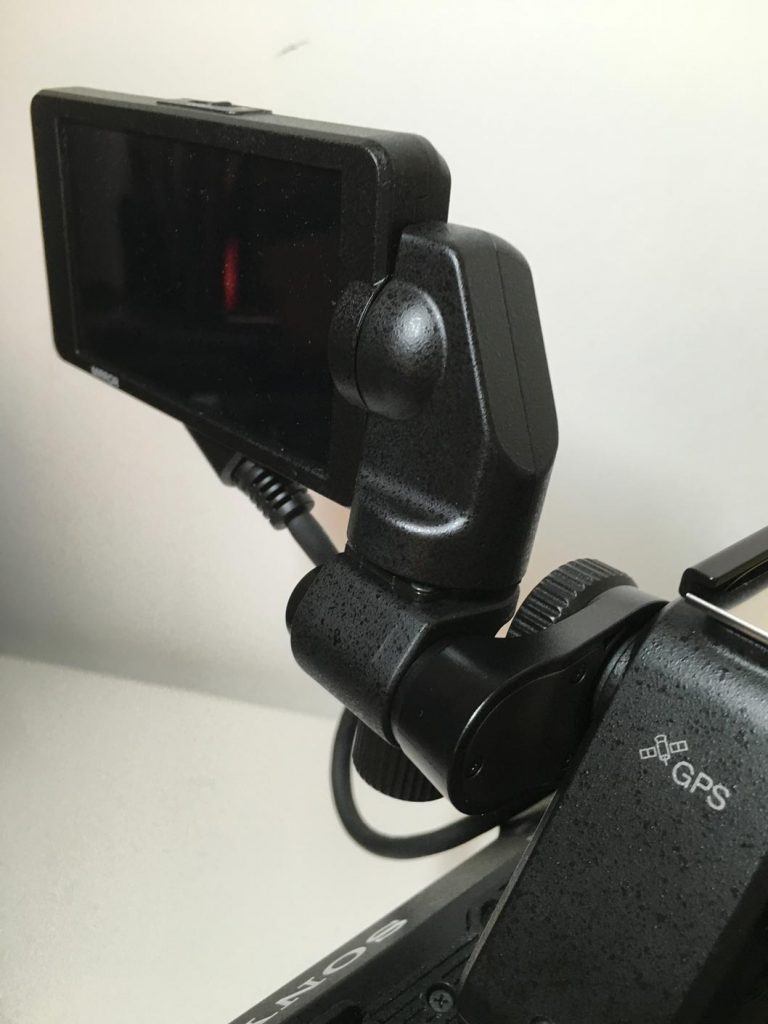
I did notice on the production model I’m testing that the illumination is a bit patchy when looking at a completely black image. The vari-angle mount for the screen is useful although I worry about how to protect the screen from banging into the camera when folded for transport in a bag.
The connecting cable is permanently attached to it and has the same Sony connector type as the FS7. In fact you can use the FS7 EVF on the FS5 if you wanted. The cable is fairly long so that you can position the screen in different places. As well as using the usual mount point on the front of the camera you can also put it at the rear of the handgrip, or on top of the camera when the handgrip is removed – which may be useful on a brushless gimbal, for instance.
Rigging the Sony FS5
Sony have clearly designed the FS5 with handycam-type use in mind. They have made few allowances for rigging it up into a full cinema-style setup. They have other cameras like the FS7 and F5/55 for that.
If you do want to rig up the camera there are several hurdles to overcome.
The first issue is that the shape of the frame of the camera’s screen is different to the FS7 so you can’t fit either Sony’s loupe or Zacuto FS7 Z-finder mounting frame. You could use a stick-on mounting frame, but the screen mount isn’t strong enough to take the weight of Zacuto’s Z-finder and it would flop around.
If you do want to add a third party EVF like Zacuto’s Gratical then you can remove the screen from its mount, which leaves a 15mm rod exposed. You can then use a third party EVF bracket to mount your viewfinder. I did see a nice alternative solution from Vocas that adds a NATO rail to the 1/4 20 socket where the screen mounts, allowing you to attach an EVF to that. The only problem is that Vocas aren’t sure they are actually going to make it. I’m sure that there will be even more third party solutions eventually.
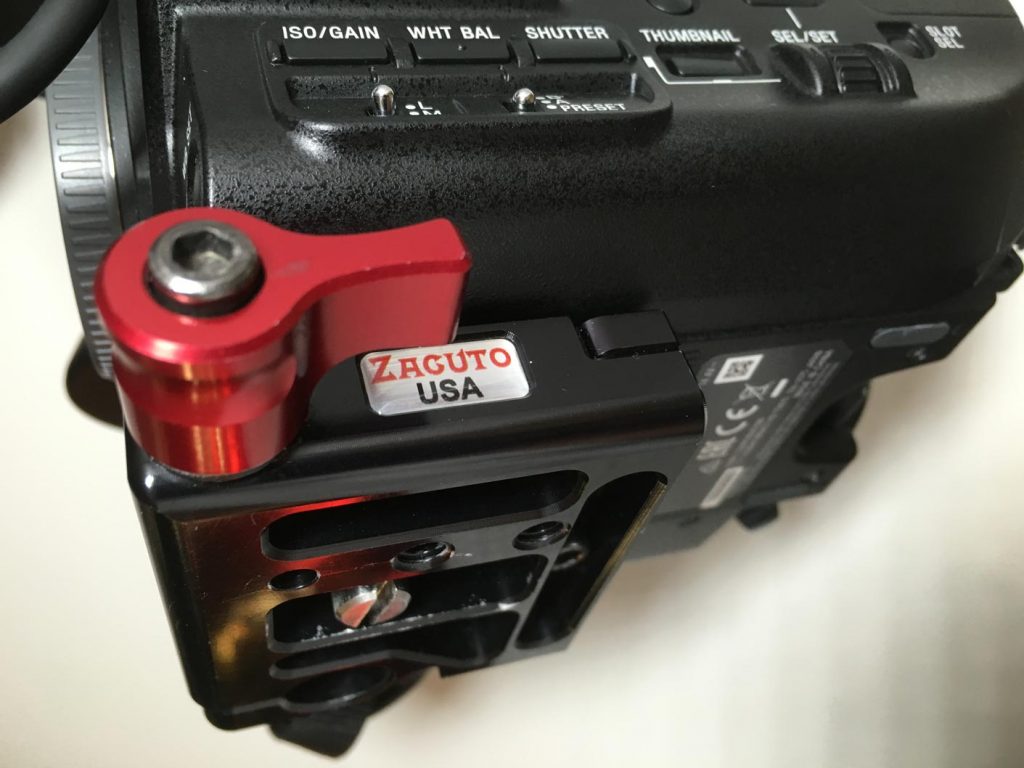
On other cameras the obvious solution to mounting issues is to replace the top handle with a third party one. Sadly, replacing the Sony top handle has a big downside – you will lose a channel of XLR audio and the other controls on the grip. You are therefore essentially stuck using the Sony handle.
If you want to use the handgrip on a rig you will need to buy special adapters from Sony that add an Arri-style rosette to it, then add a grip relocator. This all adds extra cost. The handgrip’s cable is short so you will need an extension if you want to use the grip anywhere other than attached to the side of the camera.
Anyway, if you are thinking about buying the FS5 to turn it into a cinema-ised rig, you should probably stop and consider whether an FS7 would make more sense for you.
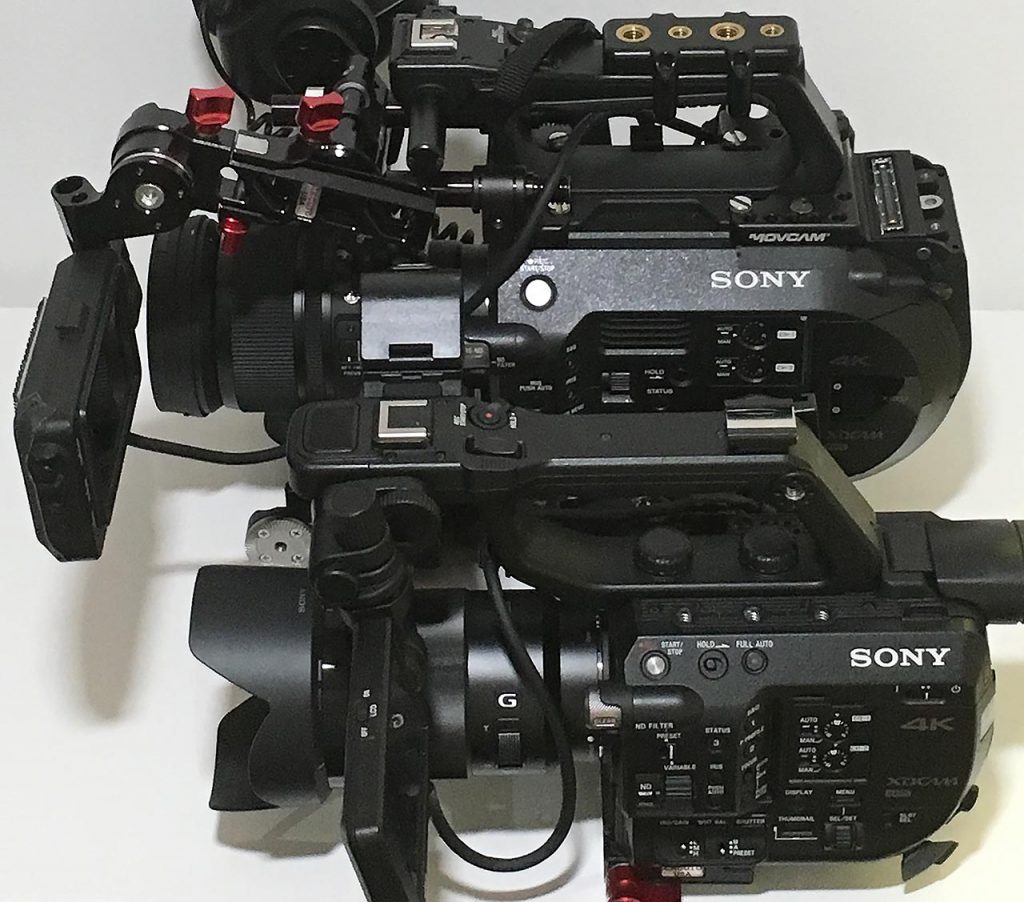
On a more positive note, it’s not all bad news in terms of mounting accessories. There are several mount points on the rear of the grip, and you can turn one into a cold shoe with an included adapter. There is also an MI shoe at the front of the grip that allows you to add a Sony wireless mic or light. There are also several 1/4 20 mounting holes along the top of the camera. These are quite close to the handle and so it makes it difficult to use them to mount Noga arms. I think they’re more useful if you want to hang the camera from grip gear in a car, for example. Vocas make a nice top cheeseplate that attaches to a PL mount support bracket it you want to use the FS5 in a more cinema-camera style.
Sony FS5 Inside
While the FS5 is very small, the sensor seems pretty much on par with the FS7; great news for anyone who’s looking either to match shots as a B-camera or on a gimbal/steadicam setup.
The FS5 can shoot 8-bit internally in 4K at 100 Mbps, or perhaps more importantly 10-bit 4:2:2 HD at 50 Mbps. The good news is that in HD at least internal recording should hit most broadcast specs for HD delivery – not something you can say about the C100 Mk II. The FS5 doesn’t offer as many codec options as the FS7, though, which has its upsides and downsides. The XAVC GoP compression is efficient enough to allow you to use SD cards as a recording media but this version of Sony’s codec will also be tougher on the computer you’re using to edit. Another thing I noticed is that my version of VLC wouldn’t play the MXF files from the camera. I’ve also heard reports that Final Cut Pro X might also have issues right now. Luckily I edit mainly in Premiere so it was easy for me to work with the footage. I shot a lot of REC.709 footage with the camera in 10-bit HD 4:2:2 and it seemed to hold up pretty well when I tried some rough grading on it.
If 4K is your thing then the FS5 onboard bitrate and depth is on the low side. This can of course be rectified with the addition of a external recorder like the Atomos Shogun. There has been a lot of confusion about the SDI and HDMI outputs of the camera. Sony told me today that the HDMI output is only 8-bit in both 4K and HD modes (which contradicts what we had previously been told). The SDI output is 10-bit 4:2:2 HD, but has no 4K option. To get a better 4K output you will have to wait for the FS-RAW upgrade option which will come at some point in the future for an unspecified price. I would like to have seen XAVC I-frame recording at higher bitrates in the FS5, but as it is it’s already significantly better than a C100 mkII.
On the subject of outputs, Sony have previously stated that when they update their firmware in January 2016, you will only get 4K picture to two of the following three output options: 1. Internal SD card, 2. External SDI or HDMI and 3. The built-in display/EVF. In other words you can’t record internally and externally plus use the camera’s EVF or screen while in 4K – in HD its not a problem. This is a major pain if you want to work with external recorders or video transmitters. One bit of good news is that the settings info will still be displayed on the camera’s built-in screen even if the image is not. Even so, my recommendation if you need this functionality is simply to buy the FS7 instead.
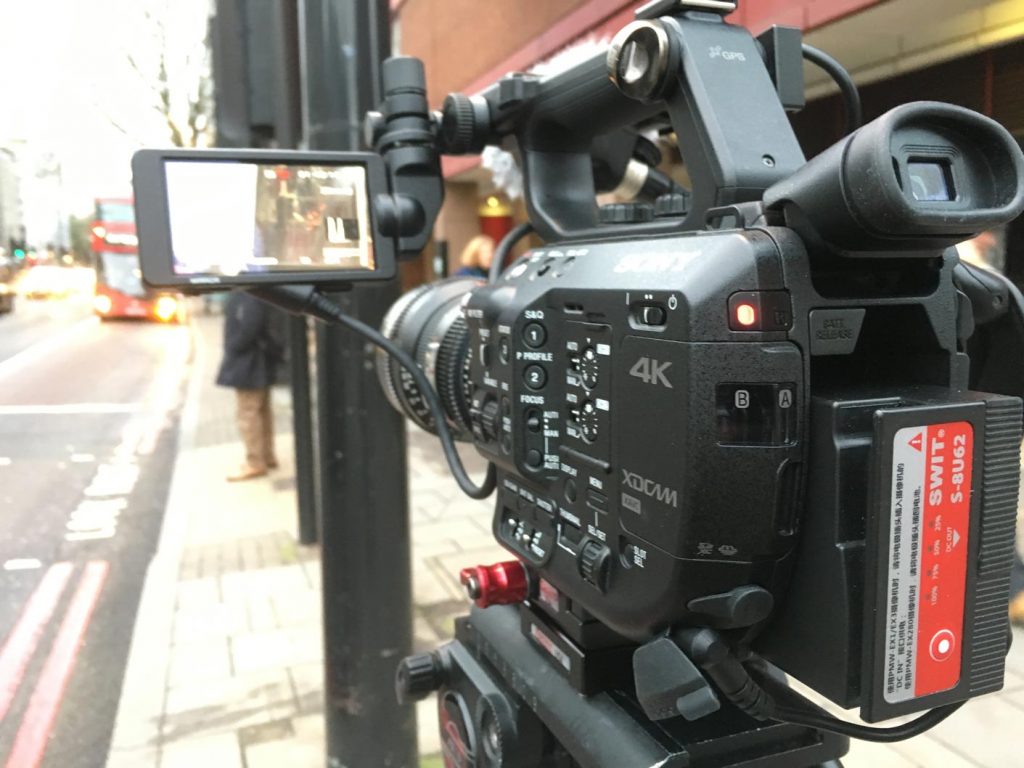
The camera has several slow motion options. S&Q mode allows continuous shooting at up to 60 fps in 1080P and there’s a buffer-based system to record up to eight seconds in full HD at 240 fps. You can shoot even higher speeds – up to 960 fps at reduced resolutions although this is a feature I have yet to fully test.
The camera has all the regular Sony colour and gamma options. S-Log3 and and S-Log2 are on the camera. I would happily use these for 10-bit HD shooting, but for 4K it might be a bit of a push to get really good results. I would probably record externally at a higher bitrate and ideally use the FS-RAW option instead when it comes out.
There’s room in the camera for two SD cards, which can be set to duplicate recordings, run in sequence or even shoot 4K on one and low res proxies on the other. As with other Sonys you have to format a card in either PAL or NTSC. So although it’s a world camera, it makes shooting at 240fps harder if you are a PAL user – you’ll need a card specially for that speed. Shutter speeds are variable as well, though, so it is possible to shoot NTSC in a PAL country and vice versa.
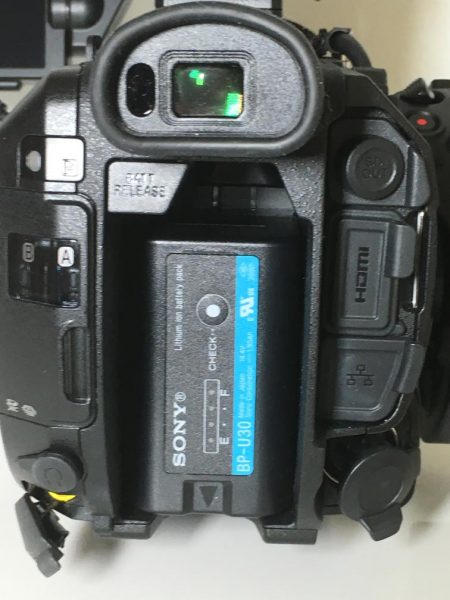
One pleasant surprise was the battery life. I’ve had well over an hour of run time with the stock BP-U30 (read: tiny) battery you get in the box. This is the same 14.4v BP-U battery type as the EX-1, EX-3, F3 and FS7 so if you’re an existing user of one of those cameras you’ll be able to use your existing batteries. You can use Swit BP-U batteries which attach via a cable but beware that the power tap placement makes fitting the cable a bit awkward. The only downside is the size of the battery charger – it hasn’t changed since the EX1. For a camera this small it would have been nicer to see a charger that fits in your bag more easily.
Sony FS5 Image Quality
Clear Image Zoom, which uses a smaller area of the sensor and some electronic wizardry to effectively increase the focal length of your lens, is a very welcome addition. It means that when shooting in HD the kit lens has a range of effectively 18-210mm when the Clear Image Zoom mode is engaged. It also works in 4K mode where the zoom factor is 1.5x – still enough to be a useful tool if you’re shooting developing action and don’t want to worry about having to change lenses. I’m sure cinema purists won’t touch the Clear Image Zoom, but for documentary and news shooters it is a feature that could well get you shots you would otherwise miss.
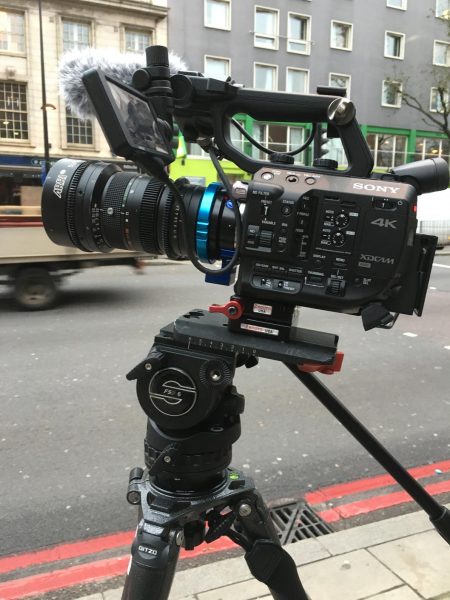
There’s also a Centre Scan sensor crop mode that allows compatibility with Super16 lenses, or 2/3 b4 ENG lenses with a MTF b4 to S16 E-mount adapter. The picture ends up being a little noisy but it’s not bad if you need the extra extended lens ranges that an older ENG-style lens will give you. One thing to note is that slow motion shooting doesn’t seem to work with this mode.
And if the kit lens doesn’t appeal then Sony’s E-mount offers a great deal of flexibility in terms of what you can hang off the front of the FS5, from the latest Canon EF glass to cheap vintage primes. This was once an area of glitches and workarounds but over the past year or so of adapting lenses for use on the FS7 and a7 cameras, it feels like this is much more of a known quantity than it once was.
Sony FS5 Review Conclusion
Finally there is a large sensor camera that you can use for broadcast work as efficiently as a handycam. It has small but significant improvements over the rival Canon C100 mkII. The key differences are in higher bitrate HD recording, the 4K option and super slow motion options. The ergonomics are much better, the camera balances well and the screen placement is good for run-and-gun. The handgrip puts all the right controls at your fingertips. Add to that the wonderful variable ND system and you have the best large sensor camera for running around at its price.
The only major weak points of the FS5 are the slow autofocus and lack of higher bitrate intra frame recording.
The only camera I would consider to be a worthy alternative for handholding is Canon’s C300 mkII at almost three times the cost – which is worth considering if you really need high bitrate internal 4K recording, Canon colour science and fast autofocus.
As a B-camera on larger productions the FS5 should work well in places where you might previously have used a DSLR, GH4 or Sony a7S. Obvious uses include on brushless gimbals and in-car rigs, although you will probably want to record externally. Joe Simon from The Delivery Men has done just that and had this to say via email:
“So I’ve setup my FS5 on the Movi 10. The body is so light that it does make it hard to use zoom lenses on the Movi but I’ve created a great setup that proves to be very powerful. Using 24, 35 and 50mm Canon L primes allows me to use the Metabones adapter and Speed Booster to create different focal lengths, and I’m using the Tokina 11-16 for wider shots.
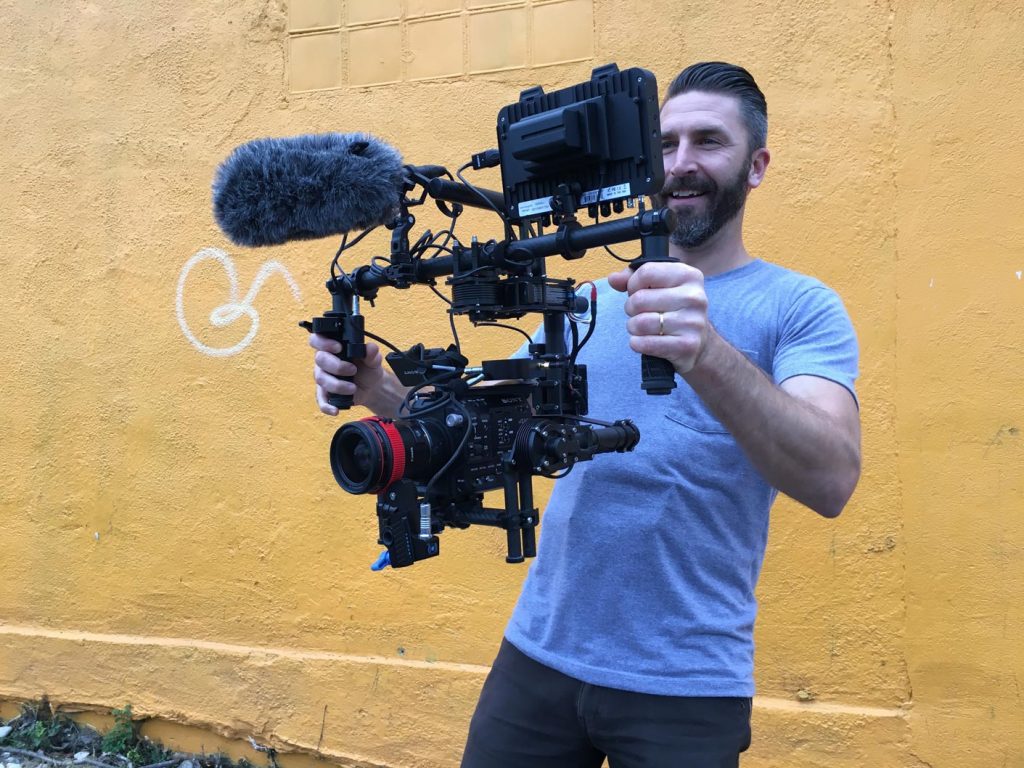
The FS5 combined with the Convergent Design 7Q+ recorder/monitor gives us a 10 bit signal and using the Redrock Micro Remote thumbwheel/wireless controller on the Movi 10 gives us full focus control. The setup is still relatively light and the footage looks awesome! I’m powering the Micro Remote with a D-tap out of a Swit S-8U63 battery on the FS5 and mounting the FS5 LCD and Micro Remote Base Station onto the camera using the 1/4-20 mounts to help balance out the heavy lenses. It’s so great that Sony has so many 1/4-20 options on top of the camera.
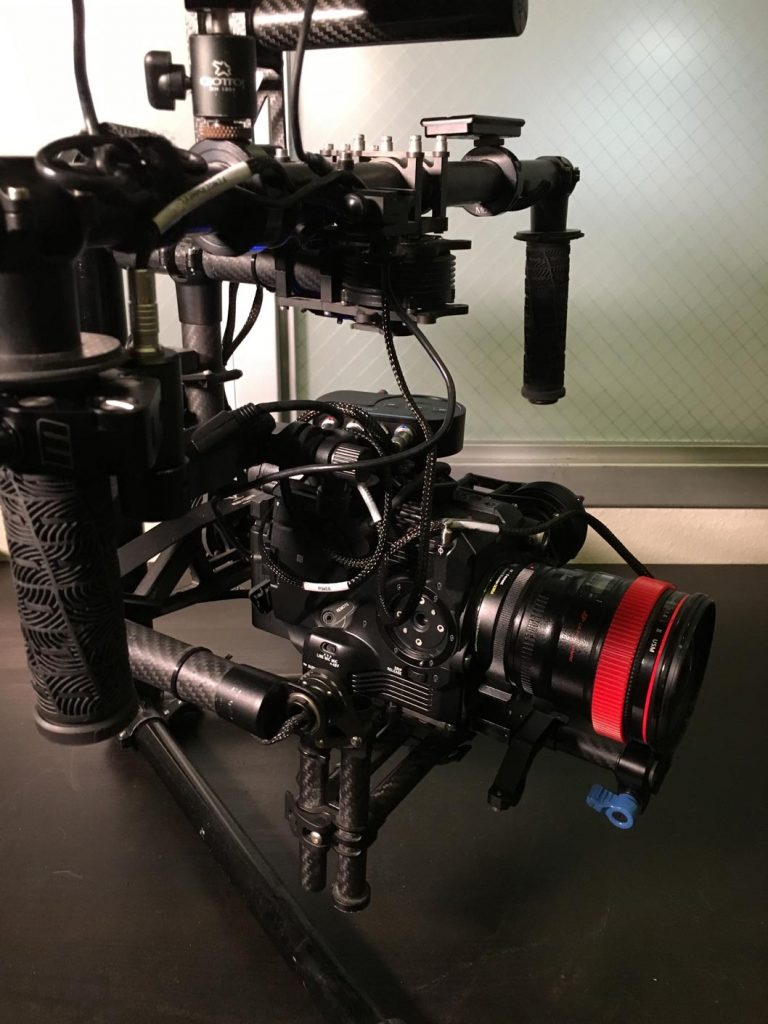
I’m honestly really excited to have a small powerful setup on the Movi that will yield the results I’ve been looking for, as well having full focus control at my fingertips or with my AC. It’s such a great setup. Can’t wait to see what we are able to create!”
At the end of the day, how important is low cost, compact size and low weight vs the ability to put it on your shoulder and the provision of 4K 10-bit internal recording? I suspect many news and documentary shooters will be using HD and not 4K much of the time. If you work mainly for web and don’t need high bitrate or slow motion, the lower cost C100 mkII or older Sonys are still worth considering. The venerable old original C300 is still an option that is widely accepted in production and can now be had for not more more than the FS5.
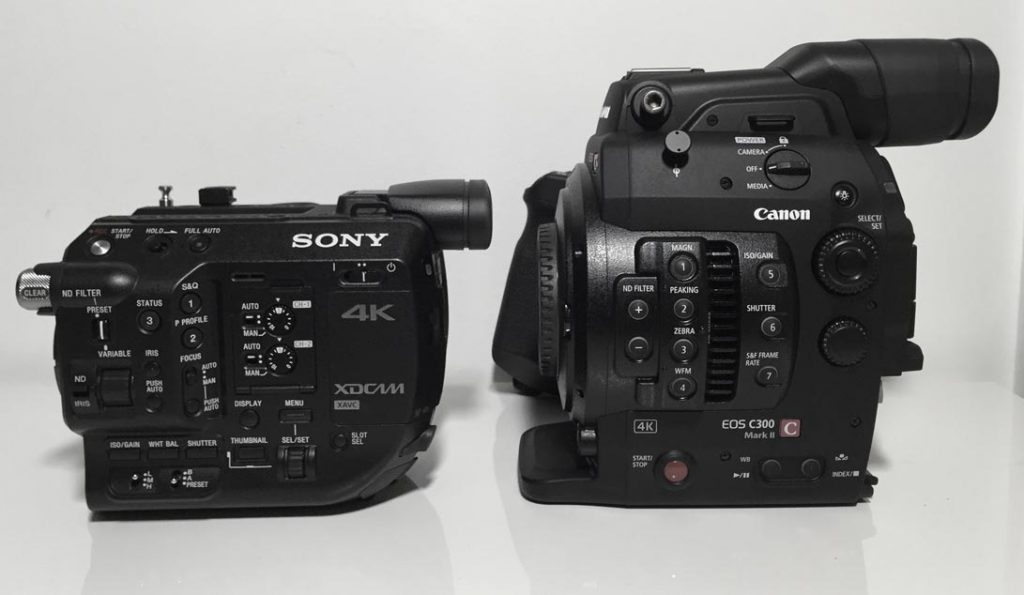
If you need a shoulder mounted camera, 10-bit 4K recording, higher bitrates and colour depth for your daily work then you should look at the FS7, F5 or C300 mkII instead.
But for the majority of solo shooters the little Sony FS5 should fit the bill just fine.



